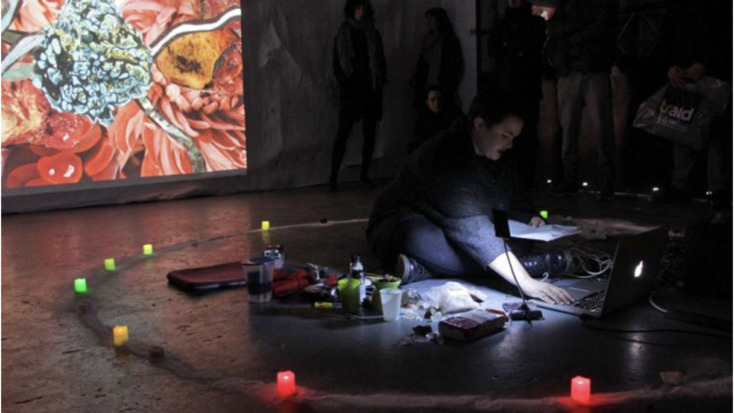Season of the Witch
In 1968 a women’s liberation group formed in New York under the acronym W.I.T.C.H; Women’s International Terrorist Conspiracy from Hell. Dressed in the stereotypical witches’ attire of conical hat and cloak, they carried out theatrical protests at high-profile beauty pageants or at locations such as Wall Street, which they viewed as epitomising the capitalist patriarchal status quo. Despite being a particularly provocative and momentarily popular offshoot of radical feminism, W.I.T.C.H. was largely overlooked until 2015, when it was resurrected by a group of Chicago based performance artists. As with the original movement, the emergence of W.I.T.C.H. two years ago resulted in a spontaneous formation of numerous ‘covens’ across the United States. Since Trump’s election last year many of these covens have been carrying out rituals en masse, attempting to oust the President from office using magical resistance.
The resurrection of W.I.T.C.H. exemplifies the current tendency of artists combining performance and activism with rituals or symbols associated with or borrowed from witchcraft. This proclivity was explored during an evening of performances and lectures, which took place earlier this year at London’s Institute of Contemporary Arts, entitled Witchy Methodologies. The press release for the event explained that it was intended to explore the way artists consider how the witch, as a figure who subverts dominant modes of production and forms of knowledge, resonates in both queer feminist histories and contemporary research-based practices. One of the contributors to this ICA event was South African artist Linda Stupart, whose work epitomises how strategies appropriated directly from spiritual paths such as Wicca are being utilised within contemporary art contexts. Stupart authors and performs spells with titles such as ‘A spell to bind straight white cis male artists from getting tin off of appropriating queer aesthetics and feminine abjection’, ‘a spell to bind Richard Serra’, and ‘a spell for binding a super trendy sexist hot young male artists internet access’.
This is a testament to Wicca’s eclecticism, which allows it to be adapted subjectively and provides one of the explanations as to why it continues to flourish in our internet age and has been adopted by so many artists. After Wicca was founded in Britain in the middle of the last century, it was embraced almost immediately by various countercultures. When it spread to the United States in the sixties, it was championed by sectors of the women’s and gay liberation movements and those who opposed patriarchal capitalism. Although the movement was formed in the fourties, many Wiccans identify with those who, during the early modern period, were victimised and persecuted as a result of accusations of witchcraft. This position is demonstrated in the book Spiral Dance by the activist Starhawk, which has become a central text in the emergence of the neo-pagan movement since it was published in 1979. She writes that to reclaim the word witch is to reclaim our right, as women, to be powerful, to be a witch is to identify with 9 million victims of bigotry and hatred and to take responsibility for shaping a world in which prejudice claims no more victims.
While Linda Stupart’s work exemplifies how artists are actively utilising the methodologies of witchcraft by performing practical magic, other contemporary artists use the archetype of the witch symbolically to give representation to feminine power and the rejection of traditional gender roles. This approach is exemplified in the multi-media exhibition by Jesse Jones which constitutes Ireland’s presentation at this year’s Venice Biennial. The central facet of the exhibition is a film presented on an almost cinematic scale, comprised of a wise woman figure speaking straight to the camera. Her monologue is both a supernal invocation and a political polemic; she urges all to ‘reject the law that all men follow’. The title of the work, Tremble Tremble, refers to a slogan chanted during Italy’s Wages for Housework campaign of the seventies: Tremate, tremate, le streghe sono tornate! (Tremble, tremble, the witches have returned!). The monologue also makes reference to Irish legislation that continues to criminalise women for having abortions. By channelling and reinforcing the sentiments of historical and contemporary social movements Jones’ witch underscores the idea that organised dissent has the capacity to transform reality.
The constellation of artists who are embracing the methodology or the archetype of the witch is as diverse as their work is different. However, as the two aforementioned instances emphasise, much of this work is consistently unified by the presence of an impulse to transcend and resolve some of the inequalities and injustices that beset our current condition. Today the figure of the witch is imbued with the possibility of empowerment. She has a conceptual catalyst for generating community, a symbol with which oppressive and outmoded structures can be undermined. The archetype of the witch reminds us that art is itself a form of magic with the power to subvert dominant modes of production, offer alternative forms of knowledge and provide new ways of living in and looking at the world.
































































































































































































































